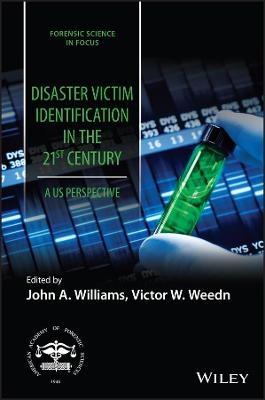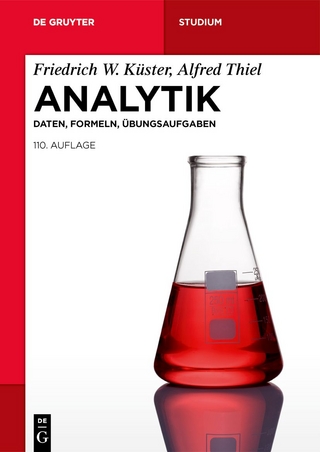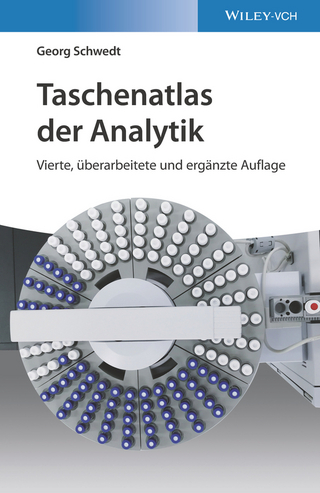
Disaster Victim Identification in the 21st Century
John Wiley & Sons Inc (Verlag)
978-1-119-65278-6 (ISBN)
Disaster Victim Identification in the 21st Century is the first book of its kind to directly address the needs of DVI practitioners in the United States, covering the full spectrum of DVI from traditional methods such as fingerprints, odontology, and anthropology to advanced DNA identification technology. Approaching DVI from three perspectives—academic, government, and private industry—this comprehensive volume examines the history and current state of the discipline, the ongoing formation of national standards, the various methods of human identification, and the key challenges and future of DVI. In-depth chapters are written by leaders in the field with personal experience in human identification and mass fatality events.
Provides practitioners with practical guidance on planning and taking part in DVI based on current national standards and best practices
Discusses continued improvement in both traditional and emerging DVI methods
Includes non-region-specific case studies and recommendations that can be easily adapted for international use
Examines ethical and legal considerations in DVI, including suggestions for standardizing the victim identification process
Describes the critical role of the Victim Information Center (VIC) in providing the comparative information required to go beyond presumptive identifications
Part of the American Association for Forensic Sciences (AAFS) series, Disaster Victim Identification in the 21st Century: A US Perspective is an indispensable resource for forensic scientists, disaster planners, policymakers, medical examiners and coroners, law enforcement and emergency personnel, and upper-level undergraduate and graduate students in forensic sciences and emergency management.
Edited by John A Williams is Emeritus Professor, Department of Anthropology and Sociology, Western Carolina University. He is a board-certified (D-ABFA retired) forensic anthropologist with more than four decades of experience working with medical examiners, the FBI, and law enforcement agencies across the United States. As a member since 1995 of the Federal agency, DMORT, he has assisted in the identification of mass fatality victims including two airline crashes and the 9/11 terrorist attack. He has served as an instructor at DMORT national trainings. Dr Williams currently chairs the AAFS ASB DVI Consensus Body. Victor W Weedn is a forensic pathologist and attorney and the Chief Medical Examiner for the State of Maryland. He is a past President of the AAFS and is on the Board of Directors of the National Association of Medical Examiners (NAME). He founded the US military’s DNA identification program and directed the Armed Forces Identification Laboratory (AFDIL). In this capacity, he was very involved in identifying service members who died in recent and past conflicts, as well as in the identification efforts of several major civilian aircraft mishaps and of the Branch Davidian conflagration victims. Dr Weedn serves on the NIST OSAC MDI Committee’s DVI Task Force and on the ASB DVI Consensus Body.
About the Editors xv
Notes on the Contributors xvii
Preface xxi
Series Preface xxiii
1 Introduction 1
John A Williams and Victor W Weedn
1.1 Introduction 1
1.2 This Book 3
2 Historical Background 7
Victor W Weedn
2.1 History of Mass Disasters 7
2.2 Early History of Mass Disaster Response 14
2.2.1 The Portsmouth Christmas Fires and 1803 Portsmouth Federal Disaster Relief 16
2.2.2 The 1835 Great Fire of New York City 16
2.2.3 1865 Sultana Explosion 18
2.2.4 The 1871 Fires 18
2.2.5 American Red Cross (ARC) 19
2.2.6 1889 Johnstown Flood 19
2.2.7 1899 San Ciriaco Hurricane 20
2.2.8 1900 Galveston Storm 20
2.2.9 1906 San Francisco Earthquake 21
2.2.10 1911 Triangle Shirtwaist Fire 21
2.2.11 1912 Sinking of Titanic 22
2.2.12 1918 Spanish Flu Pandemic 22
2.2.13 1921–22 Russian (Povolzhye) Famine 23
2.2.14 1927 Mississippi River Flood 24
2.3 1930s and 1940s Federal Disaster Relief Legislation 24
2.3.1 World War II Civilian Preparedness and Emergency Assets 25
2.3.2 Post WWII Federal Disaster Relief Legislation 25
2.3.3 Civil Defense Act of 1950 (P.L 81-920) 26
2.3.4 Federal Disaster Relief Act of 1950 (P.L 81-875) 26
2.4 1950s Federal Disaster Relief 28
2.5 1960s Beginnings 28
2.5.1 1960 Hurricane Donna 29
2.5.2 1961 Hurricane Carla 29
2.5.3 1962 Ash Wednesday Storm 29
2.5.4 1964 Great Alaskan Earthquake 30
2.5.5 1960s Federal Activism in the Wake of the Alaskan Earthquake 30
2.5.6 1965 Palm Sunday Tornado Outbreak 30
2.5.7 1965 Hurricane Betsy 31
2.5.8 Disaster Relief Act of 1966 31
2.5.9 1968 National Flood Insurance 31
2.5.10 1969 Hurricane Camille 32
2.6 Disaster Relief Acts of 1969 and 1970 32
2.6.1 1971 San Fernando (Sylmar) Earthquake 32
2.6.2 1972 Hurricane Agnes 33
2.6.3 1974 Super Outbreak 33
2.6.4 Disaster Relief Act Amendments of 1974 33
2.7 National Emergencies Act of 1976 34
2.8 National Earthquake Hazards Reduction Program (NEHRP) of 1977 34
2.9 1979 Executive Orders 12127 & 12148 – Federal Emergency Management Agency (FEMA) 35
2.9.1 1979 Three Mile Island (TMI) Nuclear Accident 36
2.9.2 1980 Mount St Helens Volcanic Eruption 37
2.10 Disaster Relief and Emergency Assistance Act of 1988 (The Stafford Act) 37
2.10.1 FEMA under President George H W Bush (1989–1993) 38
2.10.2 1989 Exxon Valdez Oil Spill 38
2.10.3 1989 Hurricane Hugo 39
2.10.4 1989 Loma Prieta Earthquake 39
2.11 1992 Federal Response Plan (FRP) 40
2.11.1 1992 Hurricane Andrew 40
2.11.2 1992 Hurricane Iniki 41
2.12 FEMA under President William J Clinton (1993–2001) 41
2.12.1 1993 Midwest Floods 42
2.12.2 1994 Northridge Earthquake 42
2.12.3 1995 Oklahoma City Bombing 42
2.13 1996 EMAC 43
2.14 FEMA under President George W Bush (2001–2009) 43
2.14.1 2001 Al Qaeda 9/11 Terrorist Attacks 44
2.15 Department of Homeland Security (DHS) 45
2.15.1 2005 Hurricane Katrina 47
2.16 Post-Katrina Emergency Management Reform Act of 2006 (PKEMRA) 48
2.17 2008 National Response Framework (NRF) 49
2.18 2011 National Disaster Recovery Framework 50
2.18.1 2012 Hurricane Sandy 50
2.18.2 Sandy Recovery Improvement Act of 2013 (SRIA) 50
2.18.3 2017 Hurricane Harvey 51
2.18.4 2017 Hurricane Maria 51
2.19 The Disaster Recovery Reform Act of 2018 (DRRA) 52
2.20 2020 COVID-19 Pandemic 52
2.21 Summary of Federal Disaster Response 53
2.22 History of Disaster Victim Identification 54
2.22.1 Scientific Methods of Identification 55
2.22.2 Military Identification Efforts 59
2.22.3 Fbi Dvi Squad 61
2.22.4 Interpol 61
2.22.5 Other International Guidance 63
2.22.6 Disaster Mortuary Operations Response Team (DMORT) 64
2.22.7 National Association of Medical Examiners 65
2.22.9 US Standards Setting Efforts 66
2.22.8 Federal Direction 65
2.23 Conclusion 68
References 68
3 Quality Assurance in Disaster Victim Identification: The Case for Standards 93
Jason M Wiersema and Michal L Pierce
3.1 Introduction 93
3.2 The Need for Standards in MDI 94
3.3 The Need for Standards in DVI 96
3.4 History of Standards Development in DVI 98
3.5 Organization of Scientific Area Committees (OSAC) 99
3.6 Discussion 100
3.7 Adoption of Standards 102
3.8 Conclusion 104
References 104
4 Medical Examiners, Coroners, and Public and Private Agencies 107
John A Williams and Jason Wiersema
4.1 Introduction 107
4.2 The Medical Examiner/Coroner System 109
4.3 The US Federal Government and Mass Disasters 111
4.4 Disaster Mortuary Operational Response Team 115
4.5 Transportation Disaster Response 121
4.6 State Reponses to Mass Fatalities 122
4.7 The Private Sector 123
4.8 Summary 123
References 124
5 DVI Morgue Operations 127
John A Williams
5.1 Introduction 127
5.2 DVI Morgue Considerations 127
5.2.1 Morgue Site Selection 128
5.2.2 Incident Command System 129
5.3 Workflow in the DVI Morgue 131
5.4 DVI Morgue Stations 135
5.4.1 Non-forensic Stations 135
5.4.2 Forensic Stations 139
5.5 Information Resource Center 141
5.6 Identification and Reconciliation 142
5.7 Summary 143
References 143
6 Forensic Odontology and Disaster Victim Identification 145
Kenneth W Aschheim
6.1 Introduction 145
6.2 Methods of Identification of an Individual 145
6.2.1 Non-Dental Methods of Identification 145
6.2.2 Dental Identification 146
6.3 Theoretical Basis for Comparative Dental Analysis 147
6.3.1 Basic Theory 147
6.3.2 The 32 Teeth Concept 149
6.3.3 Logical Direction of Change 151
6.3.4 Comparison Discrepancies 151
6.3.5 Concordant Features 151
6.4 The Antemortem Dental Record 153
6.4.1 Tooth Numbering Systems 154
6.5 Laws Governing the Transfer of Protected Dental Information 155
6.5.1 Electronic Dental Record 156
6.5.2 Issues Concerning Dental Data 156
6.6 The Postmortem Dental Record 156
6.7 The Dental Autopsy 157
6.7.1 Visible Light Fluorescence 159
6.7.2 Craniofacial Dissection 159
6.7.3 Antemortem Radiographs 160
6.7.4 Postmortem Radiographs 161
6.7.5 Types of Imaging Devices 161
6.7.5.1 Film 161
6.7.5.2 Phosphorus Storage Plates (PSP) 162
6.7.6 Digital Sensors 162
6.7.7 Radiographic Sources 162
6.7.8 Types of Dental Radiographs 163
6.7.8.1 Intraoral Radiographs 163
6.7.8.2 Extraoral Radiographs 164
6.7.9 Radiographic Guidelines 166
6.8 Intraoral and Extraoral Photographs 167
6.8.1 Postmortem Photographs 168
6.9 Study Casts 169
6.10 Denture Labeling 170
6.11 Dental Age Assessment 171
6.12 Characterization of Dental Materials 172
6.13 Reconciliation 172
6.13.1 Source Conclusions 172
6.13.2 Serial Unmasking 173
6.13.3 Criteria for Comparison and Reconciliation 173
6.13.4 Reporting 174
6.13.5 Terminology 174
6.14 Assembling the Forensic Odontology Team 174
6.14.1 Leadership Team 176
6.14.2 Administration Team 176
6.14.3 Site Assessment Team 177
6.14.4 Antemortem Team 177
6.14.5 Postmortem Team 178
6.14.6 Coding Team 178
6.14.7 Information Technology Team 178
6.14.8 Photographic Team 178
6.14.9 Reconciliation (Comparison) Team 179
6.14.10 Identification Review Board (IRB) 179
6.15 Computer-Assisted Dental Identification 179
6.15.1 Computer Assisted Post-Mortem Identification (CAPMI) 180
6.15.2 WinID3 181
6.15.3 Uvis/Udim 183
6.15.4 Dvi System International 186
6.15.5 OdontoSearch 187
6.16 Ethical Considerations 188
6.17 Demobilization and After-Action Reports 189
6.17.1 Demobilization 189
6.17.2 Preservation of Dental Data 189
6.17.2.1 Preservation of Antemortem Dental Data 189
6.17.2.2 Preservation of Postmortem Dental Data 190
6.17.3 Post-Action Follow-Up 190
6.17.4 Planning and Training 190
6.18 Conclusion 191
References 191
7 Fingerprints and DVI 195
Bryan Johnson
7.1 Introduction 195
7.2 Role of Fingerprints in DVI 197
7.3 The DVI Process and Fingerprints 198
7.4 Postmortem Fingerprinting Station 200
7.5 Personnel and Postmortem Fingerprinting 203
7.6 Postmortem Fingerprinting Process 204
7.6.1 Inspection and Cleansing 205
7.6.2 Rehydration 205
7.6.2.1 Macerated Remains 209
7.6.2.1.1 Tissue Injection 209
7.6.2.1.2 Degloving 210
7.6.2.1.3 Boiling Method 210
7.6.2.2 Thermal Modification (Charred/burned Skin) 213
7.6.2.2.1 Tendon Release 214
7.6.2.2.2 Break and Twist Method 214
7.6.2.3 Desiccation (Mummification) 215
7.6.2.3.1 Sodium Hydroxide Reconditioning 217
7.6.2.3.2 Ammonium Hydroxide Reconditioning 217
7.6.2.3.3 Detergent Soaking Reconditioning 218
7.6.3 Collecting PM Prints 219
7.6.3.1 Digital Capture 219
7.6.3.2 Powder and Adhesive Lifters 220
7.6.3.3 Ink and Paper 222
7.6.3.4 Casting 224
7.6.3.5 Photography 225
7.7 Searching/AM Records 226
7.7.1 Database Searches 227
7.7.2 AM Purported Knowns 228
7.7.3 Palm Prints and Footprints 229
7.8 Conclusion 230
References 231
8 DNA Technology and the Future of Disaster Victim Identification 233
Taylor M Dickerson III
8.1 Introduction 233
8.2 STRs and Mini-STRs 235
8.3 Lineage Markers 237
8.4 Next Generation Sequencing 240
8.5 Rapid DNA 241
8.6 Conclusion 243
References 243
9 The Victim Information Center and Data Collection: Its Evolving Role in DVI 249
Jason H Byrd
9.1 Introduction 249
9.1.1 History of the Family Assistance Center 250
9.2 Overall Function of the Victim Information Center 251
9.2.1 Incident Operations 252
9.2.2 Meeting the Needs of Families and Survivors 253
9.2.3 Briefings and Communication 254
9.3 Components of the Victim Information Center 255
9.3.1 Temporary Reception Center 255
9.3.2 Call Centers 255
9.3.2.1 Missing Persons Call Center 256
9.3.2.2 Air Carrier Call Center 256
9.4 Accounting for the Victims 257
9.4.1 Victim Information Program 257
9.5 Considerations for the Victim Information Center 259
9.5.1 Equipment and Personnel 259
9.5.2 Function and Location 261
9.5.3 Closing the Victim Information Center 262
9.6 Available Resources 263
References 264
10 Ethical and Legal Considerations 265
Victor W Weedn
10.1 Introduction 265
10.2 State Authority for Fatality Management 265
10.3 Federal Medicolegal Death Investigations 267
10.3.1 Assassination of the President or Other Federal Officials 267
10.4 Legislatively Mandated Scientific Identification 267
10.5 Missing Persons Acts and Presumptive Deaths 268
10.6 Rights of the Dead 269
10.7 Rights of Others in the Dead 269
10.8 Constitutional Considerations in Responding to Disasters 270
10.9 Emergency Powers 271
10.10 Stafford Act 271
10.11 Federal Executive Administration 274
10.12 State and Local Executive Administration 276
10.13 Military Assistance 276
10.14 Transportation Incidents 278
10.15 Terrorist Incidents 279
10.16 Infectious Epidemics 279
10.17 National Emergency Family Registry and Locator
System/National Call Center 280
10.18 International Legal Considerations in DVI 281
10.18.1 The US Department of State 281
10.18.2 Nation-specific Laws 281
10.18.3 Obligation to Identify Victims 282
10.18.4 International Disaster Response Law 283
10.18.5 International Treaties 284
10.18.6 International Humanitarian Law 286
10.18.7 International Human Rights Law 287
10.18.8 Missing and Disappeared Treaties 288
10.18.9 International Resources 288
10.18.10 Aviation and Maritime Deaths 290
10.18.11 Presumed Deaths 291
10.18.12 Customs 292
10.18.13 Telecommunications 292
10.18.14 International Framework for Risk Reduction 292
10.19 Ethical Considerations in DVI 293
10.19.1 Community Resilience 295
10.19.2 Equal Treatment 296
10.19.3 Respectful Treatment of the Remains 296
10.19.4 Respect for the Beliefs of the Deceased 296
10.19.5 Respect for Loved Ones 296
10.19.6 Respectful Communications 297
10.19.7 Haitian Example [184–186] 297
10.20 Conclusion 298
References 299
11 DVI in the Changing Twenty-first Century 313
Cynthia S Gavin
11.1 Introduction 313
11.2 Trend Analysis 314
11.2.1 Megatrend #1: Population Shift and Megacity Growth 315
11.2.2 Megatrend #2: Change in Disaster Types that Result in MFIs 315
11.2.3 Megatrend #3: Massive Technological Advancement 318
11.2.4 Megatrend #4: Social Media and Social Expectations 320
11.2.5 Megatrend #5: The Specialization of Ethics 321
11.2.6 Megatrend #6: A New Dynamic Disaster Management System 322
11.2.7 Megatrend #7: A New DVI Model 323
11.2.8 Megatrend #8: Healthcare and the National and International Privatization of Medicine 325
11.3 Forcefield Analysis 326
11.3.1 Drivers of Change: Regulation and Legal Factors 326
11.3.2 Drivers and Constrainers of Change: Politics 328
11.3.3 Constrainers of Change 332
11.3.4 A Neutral Context to Gain Insight regarding Driving and Constraining Forces 337
11.4 DVI Futures in the Twenty-first Century 339
11.4.1 The Quantum Forensics World 340
11.4.2 The Modern Crowners World 341
11.4.3 The Launch-Resistant Forensics World 342
11.4.4 The Hey Buddy Innovator World 342
11.5 Future DVI Strategy Performance 343
11.5.1 DVI Strategies 343
11.5.2 Stress-Testing Strategies Against DVI Futures 344
11.6 SWOT Analysis 350
11.6.1 Strengths 350
11.6.2 Weaknesses 351
11.6.3 Opportunities 351
11.6.4 Threats 352
11.7 Actionable Recommendations 352
11.7.1 Refresh the ME/C Mission Statement 352
11.7.2 Create an Enduring DVI Vision 354
11.7.3 Envision a Future Smart Independent Regional Forensic Science System and Move Toward Implementing This Model 356
11.7.4 Develop Alternate DVI Standards 358
11.8 Closing Thoughts 360
References 362
Index 371
| Erscheinungsdatum | 29.04.2022 |
|---|---|
| Reihe/Serie | Forensic Science in Focus |
| Mitarbeit |
Herausgeber (Serie): Douglas H. Ubelaker |
| Verlagsort | New York |
| Sprache | englisch |
| Maße | 152 x 229 mm |
| Gewicht | 714 g |
| Themenwelt | Medizin / Pharmazie ► Medizinische Fachgebiete |
| Naturwissenschaften ► Chemie ► Analytische Chemie | |
| Sozialwissenschaften ► Soziologie | |
| ISBN-10 | 1-119-65278-2 / 1119652782 |
| ISBN-13 | 978-1-119-65278-6 / 9781119652786 |
| Zustand | Neuware |
| Informationen gemäß Produktsicherheitsverordnung (GPSR) | |
| Haben Sie eine Frage zum Produkt? |
aus dem Bereich


